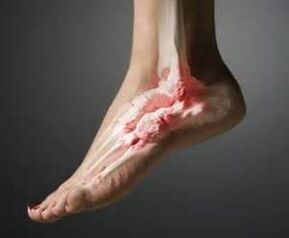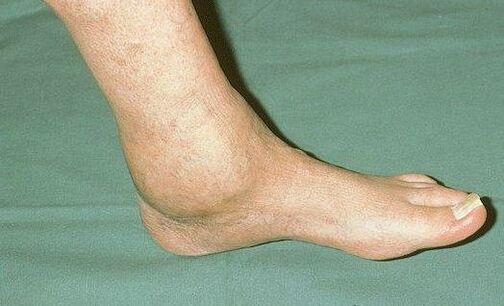
Ankle arthrosis is a dystrophic degenerative disease characterized by the gradual destruction of cartilage, joints and adjacent bone structures, as well as ligaments and even muscles, leading to impaired mobility and even disability of the patient. Such pathology can be caused by a traumatic injury in which post-traumatic arthrosis of the ankle joint develops, metabolic disorders in the body, or certain inflammatory diseases.
Do not self-medicate. See a doctor at the first sign of the disease.
The diagnosis of the pathology is made based on the patient's complaints and the results of X-rays and ultrasounds. The disease should be treated primarily conservatively, and surgical intervention is warranted only in severe (neglected) cases.
The disease is chronic, with a wavy course in which the exacerbation periods alternate with resting periods, but the progression of the pathology continues even in the absence of symptoms, so over time the ankle is completely destroyed when treated. not implemented. Older people most often suffer from arthrosis due to the natural metabolic processes in the body, but there are other causes of arthrosis.
Cause
In medical practice, there are two types of arthrosis: primary and secondary. It develops as a primary independent pathology for no apparent reason. Any secondary adverse effect, such as traumatic injury.
The main causes of the disease may be:
- diabetes;
- thyroid disease;
- overweight;
- persistent microtrauma, which can occur in athletes or people who regularly walk in high heels;
- rheumatic pathologies;
- traumatic injuries in this area (fracture, dislocation);
- inflammatory processes that result from diseases such as gout, arthritis;
- hereditary metabolic disorders that lead to thinning of tissues.

Sometimes the disease occurs in children and can be caused by:
- tissue dysplasia;
- congenital disorders;
- thyrotoxicosis;
- injury;
- inflammatory diseases of the joints.
Grades and symptoms
Ankle arthrosis has three stages that determine the symptoms of the disease. It is important to note that the disease develops gradually, so joint disorders are first insignificant and then more pronounced. However, the changes that have appeared are already incurable, and the treatment of the pathology at one stage or another consists only in preventing the progression of the disease.
In the first stage of the disease, the tissue becomes thinner, and this does not happen over the entire surface, but in separate parts - specific islands are formed.
The first degree of the disease is characterized by the following symptoms:
- excessive fatigue with prolonged stress on the legs;
- discomfort in the joint area after walking in the heel;
- mild pain that resolves at rest.
X-ray or ultrasound does not reveal any abnormalities in the joint, so doctors cannot make a diagnosis at this stage.
In the first stage of the disease, you can treat it at home with folk remedies - above all, refuse to wear heels, lose weight (if necessary), exercise, and also use some of the folk methods discussed below.
With the second stage of the pathological process in the areas where the tissue has thinned, the load falls on the underlying bone. As a result, it grows and osteophytes form, damaging healthy areas of opposite or nearby cartilage tissue. The symptoms of the second stage of arthrosis are more obvious:
- pain under less stress that does not go away immediately after it disappears;
- the occurrence of nocturnal pain that interferes with the quality of sleep;
- restriction of joint mobility in the morning (lasts for a while);
- joint response to the weather.
In the third degree, deforming arthrosis of the ankle joint develops. During this period, the tissues of the entire joint become thinner, and like the bone structures, the muscles are overstressed and convulsed, trying to keep the joint in place. Symptoms of the third degree of such pathology, such as deforming ankle arthrosis, are accompanied by complete impairment of mobility and severe pain:
- severe pain that does not stop even at rest;
- in the morning, the joint requires long-term development, even to perform minimal movements;
- crisp feeling;
- the need to take painkillers to relieve pain;
- limited mobility or even complete damage to the affected area.
Pathology, such as traumatic arthrosis of the ankle joint, is characterized by a few other symptoms:
- swelling and redness of the affected area;
- local temperature rise;
- crunching or crepitus.

Diagnosis and treatment
X-rays are intended to play a crucial role in diagnosing the disease. However, it is important for the physician to listen to the patient’s complaints, allowing him or her to make a diagnosis at an early stage when radiographic changes are not visible. In severe cases, the patient is referred for an ankle CT or MRI.
Treatment of ankle arthrosis depends on the stage of the disease. In the initial stage, it is enough to change your lifestyle and proper motor system. At this stage, massage and exercise therapy that will improve blood circulation will be helpful. Talking about folk remedies that can be used at home can reduce pain and alleviate the inflammatory process. These folk remedies that anyone can use at home include:
- rub the affected area with olive oil in the morning;
- use of burdock leaves in the form of attachment to a sore joint all night;
- making comfrey ointment and rubbing the affected area twice a day;
- take the mumiyo in tablet form and rub it into the affected joint.
There are other alternative treatments, but it must not be forgotten that they are not a panacea for the disease, and only their complex use, as well as drug therapy, diet, exercise therapy, and a proper lifestyle, prevent the progression of decay.
When it comes to medication for ankle arthrosis, it consists of the use of anti-inflammatory and analgesic drugs. In addition, patients are prescribed chondroprotectors that protect the joint for a long time (at least six months).
The use of vascular drugs such as niacin is recommended to improve the nutrition of the affected joint. Hyaluronic acid therapy is considered effective, sometimes requiring a single hormone treatment.
It is also necessary to treat the disease in combination with physiotherapy. The figure shows special exercises for ankle arthrosis, which are selected by a physiotherapist in each case. It is very important that the exercise with ankle arthrosis does not cause pain to the patient, however, the person should experience some discomfort because otherwise the procedure will be ineffective.
Among other physiotherapy methods, the following are presented:
- magnetotherapy;
- laser therapy;
- phonophoresis;
- thermal processes and some other types of exposure.
Surgical intervention of the disease is recommended only in severe cases when the joint is completely destroyed. Patients often have joint prostheses that restore the mobility of their limbs, but they also use other surgical techniques - the doctor responds according to the patient’s condition.

























